There are some culinary mixes that simply work better than others.
It could be a complementary set of flavor profiles or that one cuisine’s cooking method merges seamlessly with another’s ingredients. In these cases, two is definitely better than one.
Mozambican cuisine, and caril de caranguejo in particular, is one such fortuitous mix. Drawing on strong influences from the Arabic, Portuguese and native African food cultures, this is one crab curry you will not want to miss.

The Portuguese Contribution to Mozambican Cuisine
An all-encompassing understand of Mozambique’s cuisine requires a deeper dive into its history of cultural influences along the way.
To begin, there are clues – including potential eating tools – that suggest the lands of Mozambique have been inhabited by humans as early as 100,000 years ago. The evidence suggests that the prevailing lifestyle for these inhabitants was that of the hunter gatherer, and it was only until the Bantus arrived somewhere between 100-300 AD that agriculture became an integral part of local eating.
Several centuries later, the Arabs arrived along the coastlines of Mozambique and set up a trading outpost nearby. Until the arrival of the Portuguese (as we’ll soon see), the local tribes and Arabs developed a mutually beneficial trading relationship that flourished for centuries.
The incoming Arab trade had a significant influence on local eating. In addition to the introduction of salt and methods of food preservation, the Arabs also brought with them ingredients like onions, garlic, bay leaves, and fresh coriander that are still common in Mozambican cuisine today. As an interesting little fun fact, the modern name for Mozambique actually comes via a derivative name of a ruling Arab sultan, Musa bin Ba’ik, to the region prior to the Portuguese arrival.
Which brings us to arguably the most significant culinary contribution of all.
You May Also Like…
Love crab curry? Then you’ll love this chili crab in spicy tomato sauce from Singapore.
Enter Vasco de Gama and the Portuguese
In the late 1490s, King Joao II of Portugal wanted to expand the reaches of Portuguese trade into the Eastern world. To this point, the Arabs – and, to a lesser extent, the Venetians – had enjoyed the rents of a monopoly trading relationship with the Indies.
To lead this campaign, Joao ultimately commissioned Vasco da Gama and equipped him with a fleet of three ships to open a new ocean route between India, the Iberian peninsula and all stops along the way. Foreseeing a potential docking around the southern tip of Africa, da Gama contracted two Arabic speakers as well as a Bantu speaker as part of his crew, and the expedition set off in July 1497.
By March 1498, da Gama and his voyage made it to the shores of Mozambique. Initially making contact with the friendly Tsonga people, da Gama affectionately named the land Terra de Boa Gente, or the “Land of Good People.” Soon, however, he came into the Mozambican settlements of the Arabs, who were less accommodating to the non-Muslims. After initial successful pretending to be Muslim for nearly a month – and even gaining audience with the Sultan of Mozambique – da Gama’s charade fell apart and the Portuguese had to flee Mozambique away from the increasingly hostile Arabs.
After leaving Mozambique, Da Gama would continue onto India and then back to Portugal, which cemented a successful new trading route that would prove to be immensely profitable to the Portuguese kingdom.
A very significant element for da Gama’s success came as a result of the freshwater ports that the eastern side of Africa had to offer, and this was not at all lost on da Gama and King Joao. Following his successful voyage, the Portuguese would continue to send armadas through the contra costa (“opposite coast”) for several years following da Gama’s initial voyage.
Ultimately, the Portuguese became a little more forceful in their desire to engage in Mozambique. Hoping to develop a monopoly on the spice trade of this new route, the Portuguese in 1502 – again lead by da Gama – colonized Mozambique and the port city of Sofala and established their coveted exclusive trading rights along the way.
This colonization and overarching Portuguese influence would last for centuries until 1975, when Mozambique finally became an independent nation.
Contemporary Mozambican Food
Between 1498 and Mozambique’s independence in 1975, the Portuguese played an immense role in the shaping of modern day food culture.
Early on, the Portuguese introduced a plethora of new ingredients to the region. A basic (but definitely not exhaustive) list of these introduced ingredients include: lemons, limes, oranges, tomatoes, chilis, domesticated pork, pineapples and corn. Of course, one of the most popular Portuguese contributions to this day is peri peri (more on this later).
Mozambican Eating
The Mozambican food culture is one of simplicity yet strange complexity. Like many African nations, especially those with as abundant a coastline as Mozambique’s, much of the cuisine highlights the vibrant variety of seafood alongside local produce. Fruits in particular like mangoes, bananas, coconuts and various citrus fruits are aplenty.
Like most other African nations, staples to the cuisine involve meals made from various cereal grains like maize and sorghum, but there is also an prevalence of rice in the cuisine as well. More often nowadays, many will have pregos, or steak sandwiches, made by street vendors as a cheap way of enjoying the main lunchtime meal of the day called the almoço.
Still, one of the very traditional and still common dishes enjoyed for an almoço is the caril. These curries are served hot with rice or cornmeal dough and can feature various types of seafood. Caril de caranguejo, for example, is “the curry of crab” or a crab curry.
These carils are enjoyed with spicy chutneys like manga achar (a mango chutney)… and of course there’s a lot of peri peri to be had.
About this Crab Curry Recipe
In general, dishes from Mozambican cuisine are fairly low maintenance and easy to prepare, and caril de caranguejo is no exception. There are two important components to the this crab curry in particular: the peri peri and the crab curry itself (love crab? Try this other recipe on chili crab from Singapore)
First, there’s the peri peri. If you were to translate the name from its originating Swahili into English, you would literally call this sauce “pepper pepper,” which would not be at all inaccurate a description. At the core of any peri peri are crushed chili peppers, lemon juice and oil.
To prepare your peri peri, you’ll start by grinding and combining your ingredients together either in a mortar and pestle or with a food processor (on Amazon). For us, we ended up choosing the latter approach, but you can really go either way with equally pleasing results.
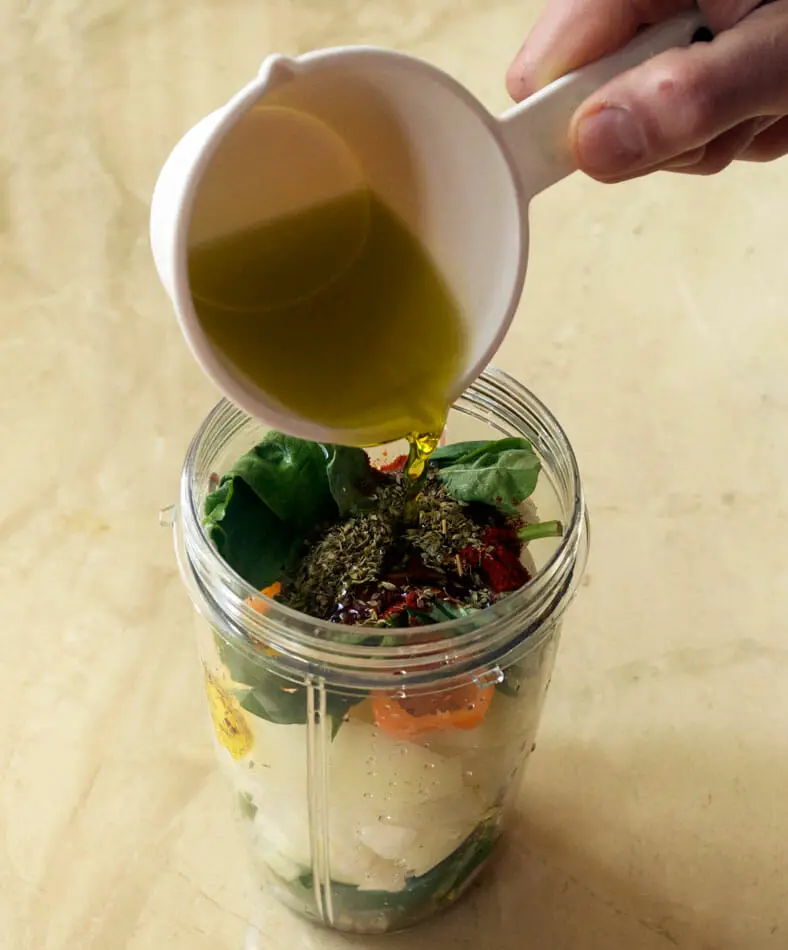
With your ingredients crush and mixed together, you then want to heat and simmer the peri peri, which will help meld the flavors together into a smoother, even slightly smokier taste. If you end up with a little extra peri peri left over after making this crab curry, that’s not at all a bad thing.
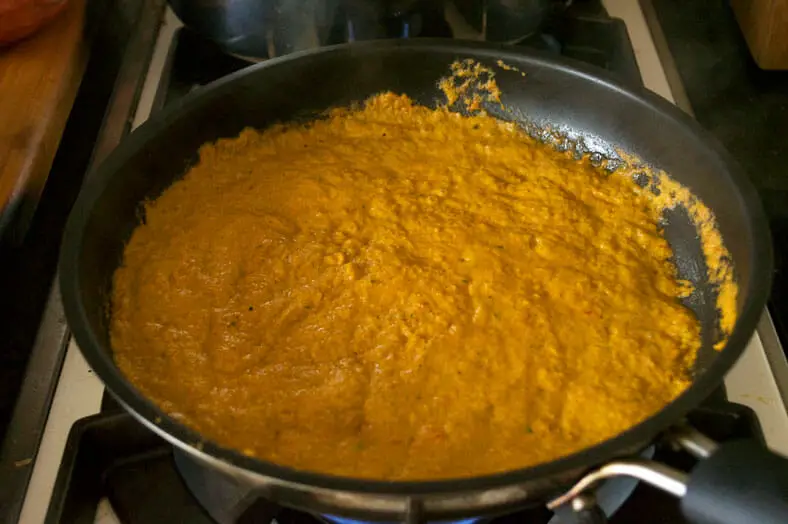
Once your peri peri is prepared, you can focused on the main event: the caril de caranguejo. As we mentioned earlier, this type of cooking is simple enough that creating your crab curry requires no more than combining together your ingredients in a fairly sequential order.
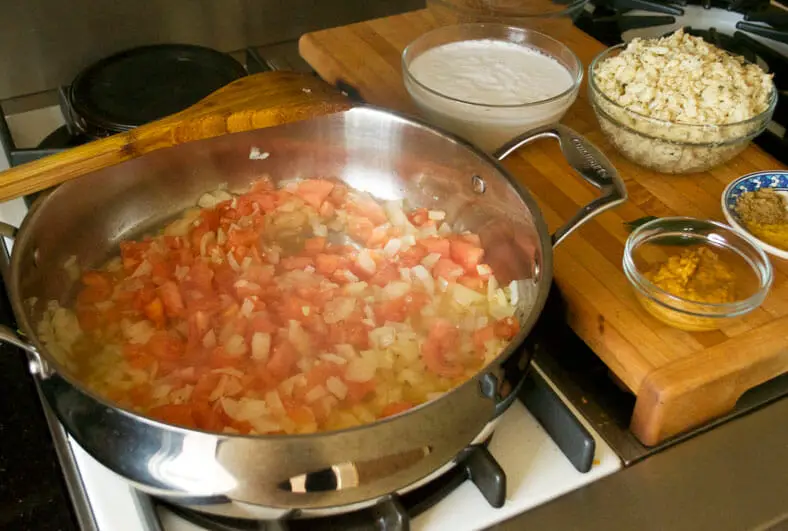
First, you’ll start by creating a mixture of softened onions, garlic and tomatoes. As these ingredients start to sweat and the tomato begins to break down, you’ll add some of the peri peri you’ve just finished preparing. Add in some spices and other aromatics, and you’ve got your base ready for the crab.
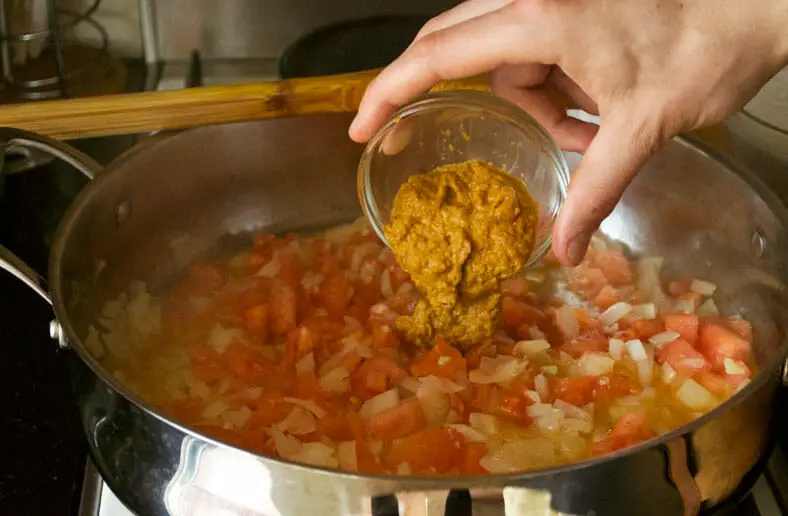

Next, add your crab and mix around to let it soak up the surrounding flavors before adding your final ingredient of coconut milk. At this point, you’ll simply let your crab curry simmer for ~10 minutes, after which point you’ve finished making caril de caranguejo!


Our Take on the Recipe
Somewhat paradoxically, we created variations of a caril de caranguejo recipe that with both more steps and more shortcuts than those offered by our original reference recipe. You’ll see what we mean here in just a bit.
For starters, while a full crab would have looked so much more aesthetically appealing, we went ahead and used pre-shelled crab meat in our crab curry. This choice was made in part because the overall selection of fresh crab around us is less impressive than what is on offer of the coastlines of Mozambique. On top of that, it really is a lot easier and more simple to cook with pre-shelled meat.
Next, the original recipe makes note of “chili sauce” but offer the reader no suggestion on how to make it. In order to be a little more helpful, we compiled and spelled out the steps for making a homemade peri peri that ultimately becomes a part of your crab curry. We do offer proportions that leave you with a little extra peri peri for discretionary use, which we maintain is a very good thing.
In the crab curry itself, we added aromatics and spices like bay leaf, coriander, parsley and cumin into the mix as well. In addition to the peri peri, we increased the amount of curry to ratchet up the heat of our curry as well. If you don’t want the extra heat, just scale down the curry powder by about half. If you love the idea of spicy soup, you will want to try our other recipe on a fish soup – served over vermicelli. Or if you prefer to stick to curries instead, like this one, try our other salmon curry with coconut milk from Bangladesh, served over white rice (shorshe).
Finally, we added a splash of white wine into our crab curry between the onions/garlic/tomatoes and the spices. It wasn’t an ingredient we found in any version of caril de caranguejo during our recipe research, but cooking with wine – especially seafood – was a technique brought over to Mozambique from the Portuguese early on. Maybe it’s just our penchant for cooking with wine, but we figured the dish could use a nice splash of it.
Other than that, caril de caranguejo is a delicious, wholesome crab curry that is super simple to make, and it’s as beautiful a combination of multiple culinary influences as you’ll find it. Seafood is so delicious and so under utilized and eaten in the United States! Add some more fish and seafood to your diet.
Enjoy!
How do you prepare caril de caranguejo? With your own peri-peri homemade? Comment below!
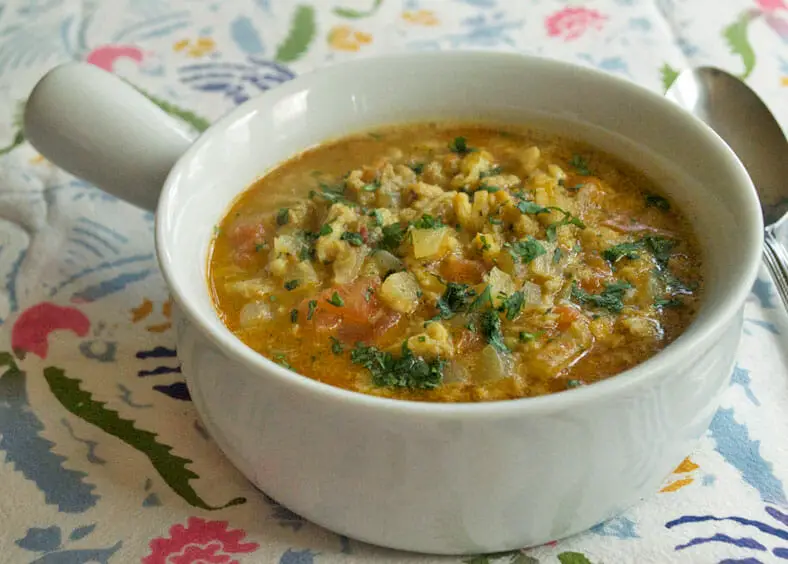

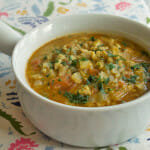
Caril de Caranguejo: Mozambican Crab Curry
- Total Time: 36 minutes
- Yield: 4 people 1x
Description
Caril de Caranguejo: Mozambican Crab Curry with olive oil and bay leaf.
Ingredients
- 1 pound of crab meat
- 2 tablespoons olive oil
- 2 medium sized yellow onions, diced
- 2 cloves of garlic, minced
- 4 medium tomatoes, peeled and diced
- ¼ cup white wine
- 3 tablespoons of peri peri sauce (see below)
- 1 bay leaf
- 1 teaspoon of ground cumin
- 2 teaspoons of ground coriander
- 2 teaspoons of yellow curry powder
- 1 teaspoon black
- 1 teaspoon sea salt
- 1 14 oz can of coconut milk
- 1 handful of parsley, freshly chopped for garnishing
- Extra salt and pepper to taste
Peri Peri
- 1 cup of olive oil
- 1 medium sized yellow onion, roughly chopped
- 6 garlic cloves, roughly chopped
- 1 handful fresh basil, roughly chopped
- 1 small red bell pepper (or ½ a medium one)
- 2–3 fresh jalapeno peppers, deseeded and coarsely chopped
- 6 fresh red chili pepper, coarsely chopped
- 1 tablespoon smoked paprika
- 1 tablespoon dried oregano
- 1 teaspoon freshly ground black pepper
- 1 teaspoon sea salt
- Juice of 1 lemon
Instructions
Stage 1 – Prepare the Peri Peri Sauce
- In a food processor (on Amazon) or blender, combine all the ingredients for your peri peri sauce. Blitz and process until you get a sauce of a smooth consistency
- Next, pour your peri peri into a small pan and take over medium-low heat. Let it simmer and cook over medium-low heat for ~10 minutes while you stir occasionally. In the meantime, you can get started on your caril de caranguejo below
Stage 2 – Start your Crab Curry
- Take a large saucepot over medium-high heat with your olive oil. Once the oil is heated, add your onions and cook for ~2 minutes as they start to sweat
- Next, add your garlic and tomatoes. Cook for another 3-4 minutes as the tomatoes start to soften and create a stew
- At this point, your peri peri sauce should be perfect and can be taken off the heat. Take 3 tablespoons of your peri peri along with your white wine and add both to your saucepot. Stir well
- After 1 minute of mixing all the ingredients together (and ensuring the peri-peri has dissolved), add your curry powder, cumin, coriander, pepper, salt and bay leaf to the pot. Stir well until all your spices are well mixed in
- Next, add all your crab and stir well. You want the crab to change color as it absorbs the colors and flavors from the spices and other ingredients. Cook for ~1 minute here
- Finally, add your coconut milk. Once you do, reduce the heat to medium-low and simmer your crab curry for 10 minutes, stirring occasionally
- When the caril de caranguejo is done and simmered, take off the heat and serve
- Prep Time: 10 mins
- Cook Time: 26 mins
- Category: Main Dishes
- Cuisine: Mozambican


My family in the Philippines will totally enjoy this! Love Peri-peri with chicken but am sure even better with crab!
Both are awesome, Manila Spoon! Peri peri is good with all 🙂